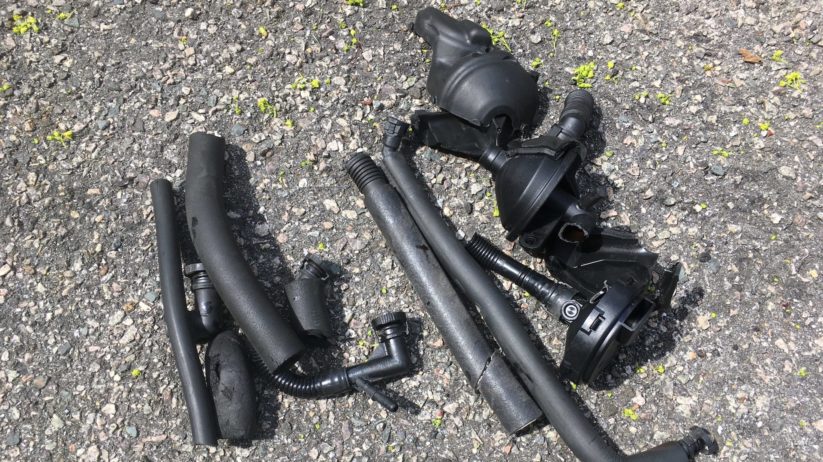Back in early March, I posted the first part of this series describing how when I bought the E53 X5 last September I basically abandoned my daily-driver E39 stick-sport in my driveway. This worked well because the 190,000-mile E39 had a number of issues: front-end shimmy due to either worn upper control arms or brake rotors with deposits on them, bad pixels in the gauge-cluster display, an intermittent misfire from a bad stick coil, a cooling system of unknown age, and a crankcase-ventilation valve that needed replacement.
In contrast, the 270,000-mile X5 somewhat surprisingly seemed to need little—plus it was an ultra-rare sport-package car that I could tow with if necessary, and would be a better ride for me over the winter. However, dormant cars turn into dead, worthless cars, so when spring began to poke its head up, I planned to give the E39 some love and bring it back into the light. I sent the instrument cluster out to be repaired so the cryptic messages on the pixel display could be deciphered, and ordered parts to replace the crankcase-ventilation valve (CVV), which seemed prudent since the underside of the oil cap was showing the classic mustard-mayonnaise combo.
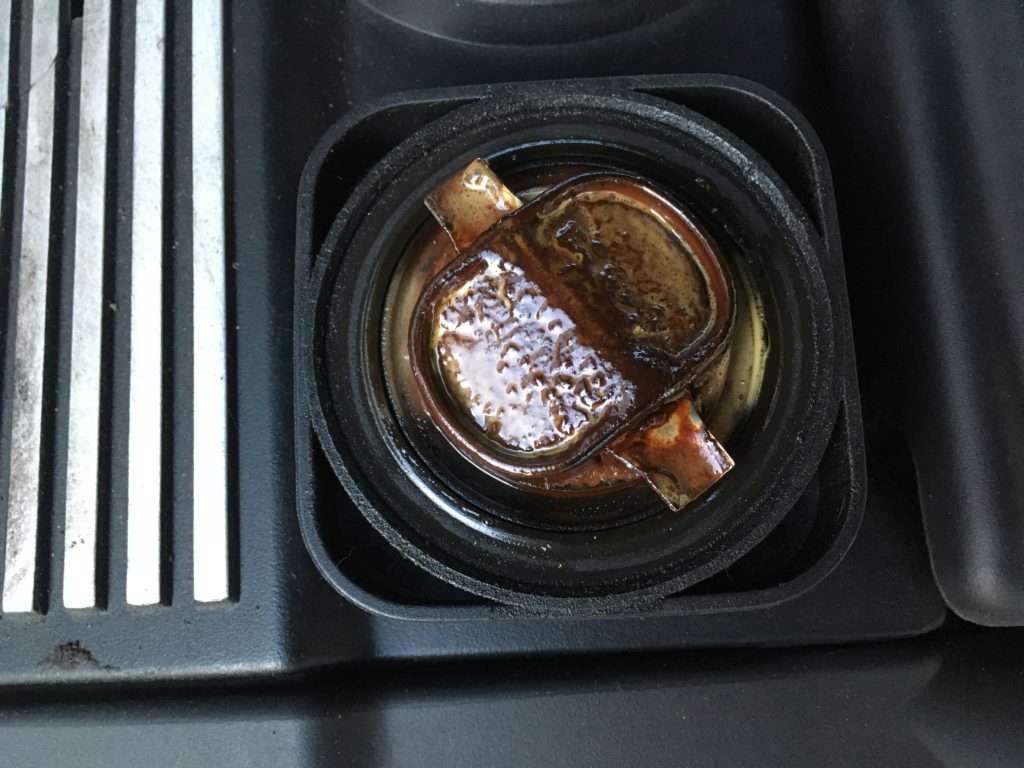
I thought this was the “I need the CVV replaced” calling card.
Ordering the CVV and the three attached hoses was interesting: The cost of the four genuine BMW parts totals nearly $300, but if you look on eBay, you can find an unbranded, presumably Chinese-made set for as low as $30. I’ve never seen such a big spread on parts cost. I called up Paul Wegweiser at Maximilian and asked if he could put together something for me using decent-quality vendors for somewhere between those costs. Apparently one hose isn’t sold by Reinz or Febi and had to be obtained through the dealer. Paul ordered a Febi valve and OE, Febi, and Reinz hoses, and got them shipped out to me for about $160.
And then the coronavirus pandemic rolled in.
On the one hand, I had (and have) nothing but time on my hands, but on the other hand, when I’m not really driving anywhere, the wind kind of went out of the sails of reviving the E39 as my daily driver.
Still, I’d just bought these parts. Their destiny was to be installed. I do not shirk on destiny.
I hadn’t done a CVV in years. My first was the one in my 1999 E39 528i sport wagon; that one did the classic thing of freezing in the position where it sent oil into the intake manifold and nearly hydro-locked the engine. (Live-and-learn tip: Don’t start a car that has a CVV of unknown age and condition in extremely cold weather, run it for five minutes, shut it off for five minutes, and then run it again, since that can separate water from the oil but not boil it off. If you start it, leave it running.) If memory serves correctly, I pulled the intake manifold off so I could clean all the oil and yellow snot out of it. Then, when I replaced that car with the E46 wagon, I replaced its CVV as part of pre-winter prophylactic maintenance so it wouldn’t happen again. On that one, I did it with the manifold in place, but found the valve difficult to reach and the hoses very challenging to attach.
There are dozens of videos on CVV replacement, but the most thorough step-by-step one is this three-part video from our friend Gordon Arnold (aka Otto) of the late, great departed Bavarian Autosport. All Bavauto/Gordon/Otto videos are among the best and most professional ones out there, and in this one, he does a great job of describing the mate-and-rotate move you need to do to install the hose that runs to the front of the valve cover. Without knowing this maneuver, you’re screwed.
I engaged the CVV repair as I do many things: a bite at a time. In the first nibble, I removed the air filter, cabin filter, fuel-rail cover, bellows, and throttle body. Man, that’s a lot of black plastic!
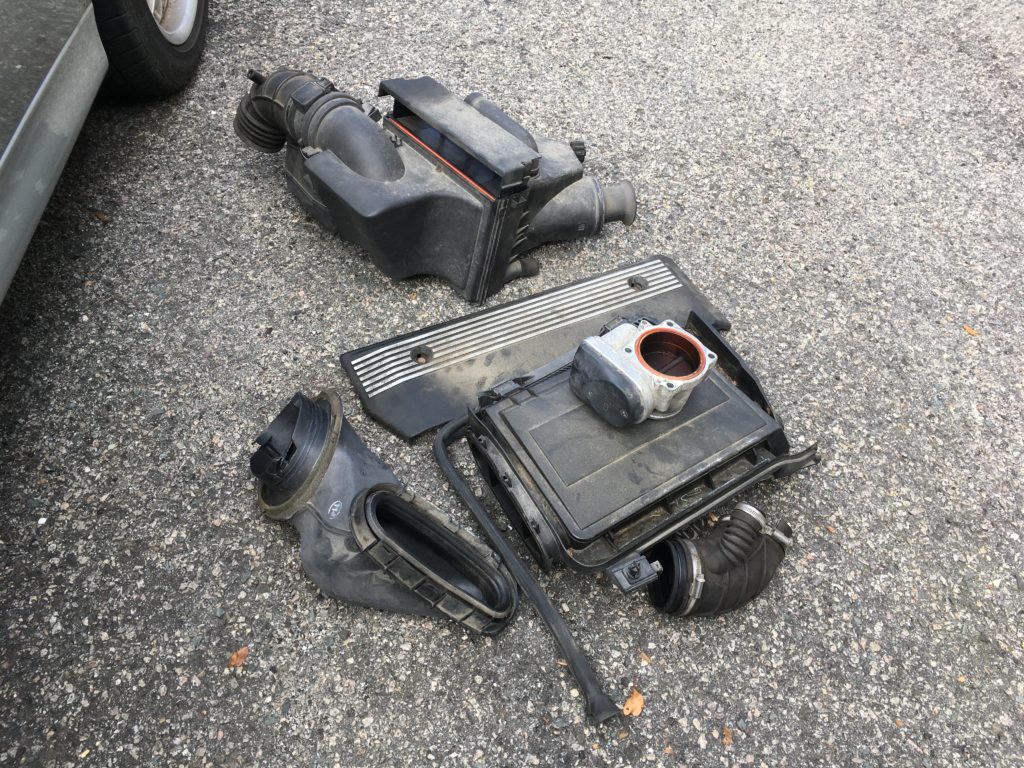
The first layer of stuff to pull out to access the CVV.
While I was yanking things out of the engine compartment, I also resolved to replace the hose connecting the auxiliary air pump, which was split when I bought the car. At the time, to clear the code, reset the check engine light, and get the car inspected, I jammed a right-sized section of rubber hose inside the plastic hose. I’d bought the correct replacement hose four years ago, but never installed it. No time like the present.
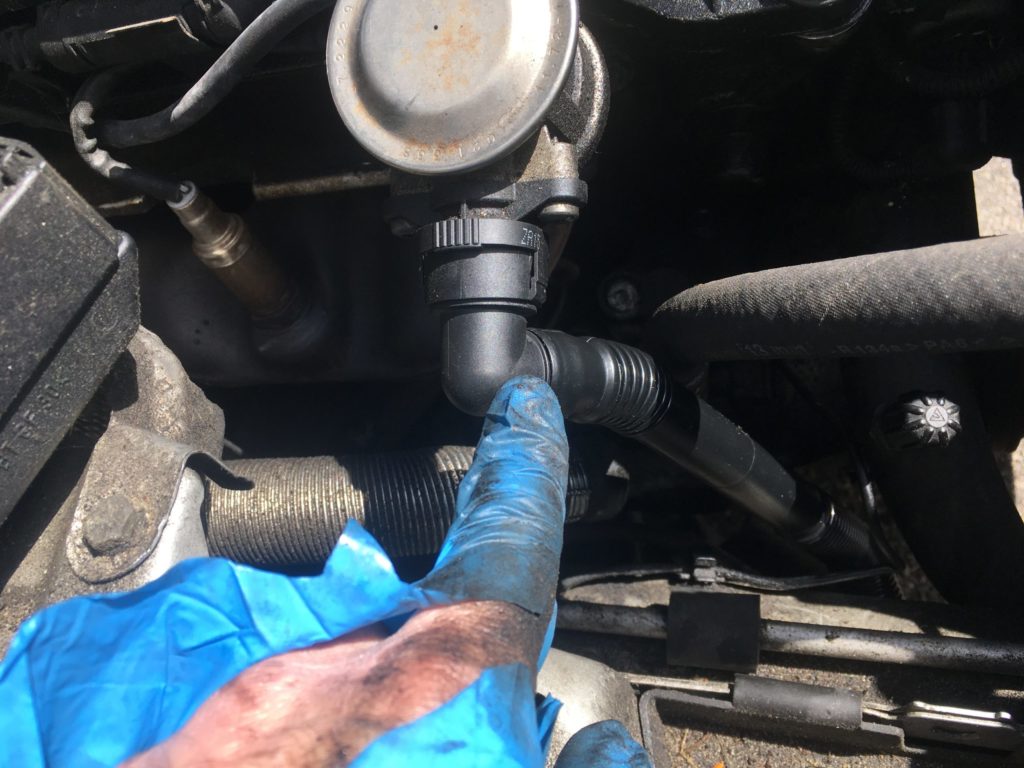
The hose to the auxiliary air pump on the right side of the engine.
Next, the CVV itself. First I needed to unscrew it, and this was challenging since I had trouble getting a good angle on the two Torx screws holding it in, so much that the heads began to strip. I very carefully undid them a sixteenth of a turn at a time while trying as hard as possible to have the Torx bit aligned with the axis of the screws and putting a lot of inward pressure on them. Once I got them out, I put a pair of new screws on order.
To remove the CVV and the hoses, the usual advice is simply to wreck them—to twist them until they snap, which they will, since with age, the plastic gets brittle. But these all wanted to remain intact. I wound up having to reach in with tin snips and cut the hoses, but with half a hose still attached to the valve, I had to twist it and break it to get it out.
When I had the CVV and all the hoses removed, I inspected them, and was surprised by what I found. They all were OE parts in very good condition. None of the plastic was brittle. And, most surprising, neither the valve nor any of the hoses was dripping with the dreaded yellow mustard/mayo snot indicating a failed valve. The bit of yellow under the oil cap was probably from ring blow-by from the 190,000-mile M54 engine. I was doing all of this work for nothing! I should’ve put the time and expense into doing prophylactic maintenance on the cooling system instead.
Sigh.
I don’t usually get it wrong. I usually save hundreds, maybe thousands of dollars per repair by diagnosing it and fixing it myself. Oh, well; as Larry Bird said after a game in which the Celtics were down by one, he was fouled, went to the line, and bricked both free-throws, “I ain’t gonna lose no sleep over it.”
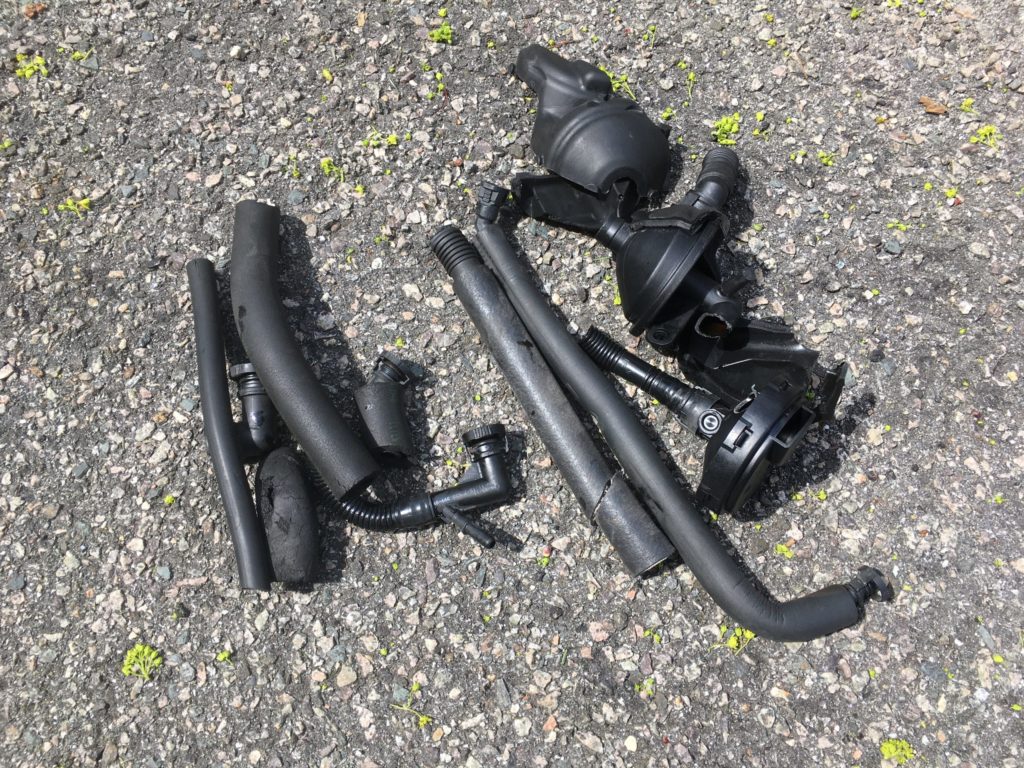
The apparently unnecessarily removed CVV and related hoses, plus the long aux air pump hose.
Because the updated CVV is the cold-weather version and it’s surrounded by foam, it’s really challenging to get it up under the intake manifold where it’s supposed to go. You’ll swear it won’t fit. You just need to look at the holes for the Torx screws and where they go and keep shoving it up there until the foam deforms.
Then, following Gordon Arnold’s excellent video, I got the difficult-to-attach hose to the front of the valve cover installed, although it was not easy to do so. Before I reinstalled the throttle body, I gave it a good cleaning.
I hoped to button everything back up in one more repair session, but when I went to install the upper intake boot, I found that the underside was split open. I was miffed that I hadn’t noticed this before and now had to order it and wait for it to arrive, but it’s not like the car was going anywhere. Five days later a new one was at my door.
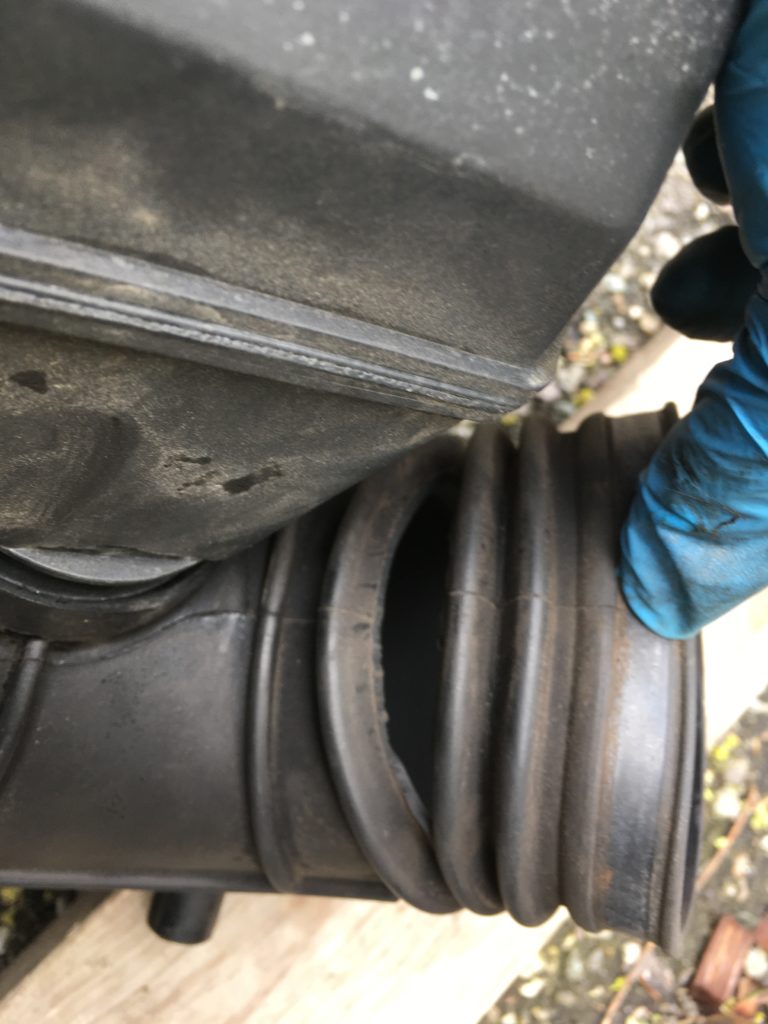
D’oh!
With the unnecessary CVV replacement buttoned up, I next wanted to address the intermittent misfire code I’d been getting by replacing the stick coil that was causing it. Back in the fall, I’d plugged in a code reader and identified it as cylinder #5, but I wanted to verify this. I started the car and let it run, but the idle was smooth and it didn’t throw a code. I ran it around the block illicitly a few times (it’s currently unregistered), but the problem still hasn’t reappeared. I’ll just wait and see.
However, while I was running it around the block, I did get the chance to stab the brake pedal until my inner ear said “STOP DOING THAT!” This had the intended effect of cleaning most of the rust and deposits off the rotors. I won’t know for certain about pulsation and shimmy until I get to drive the car at speed, and I won’t do that unless and until it’s registered, and that ties into a larger question of the fate of both it and the X5. I’m currently leaning toward selling the X5 and keeping and re-registering the E39. I’ll make that decision over the next few weeks.
But at a minimum, it feels good to have showered some love on the E39 and exercised it. I hope it’s not a singular occurence.—Rob Siegel
Rob’s new book, Resurrecting Bertha: Buying Back Our Wedding Car After 26 Years In Storage, is available on Amazon here. His other books, including his recent Just Needs a Recharge: The Hack MechanicTM Guide to Vintage Air Conditioning, are available here on Amazon. Or you can order personally-inscribed copies of all of his books through Rob’s website: www.robsiegel.com.

